Walking Comfort in The Dairy Barn
Walking comfort; improves animal welfare and with it profitability of dairy cows. Improved animal welfare for higher profitability with Sure-footedness, Claw health, Dry walking areas. In cubicle barns, the walking areas link the essential areas cows move between (feeding, drinking, lying down). A functioning dairy cow system requires unrestricted, pain-free movement.
Cows show us what they need: a soft and slip-resistant ground and prefer rubber.
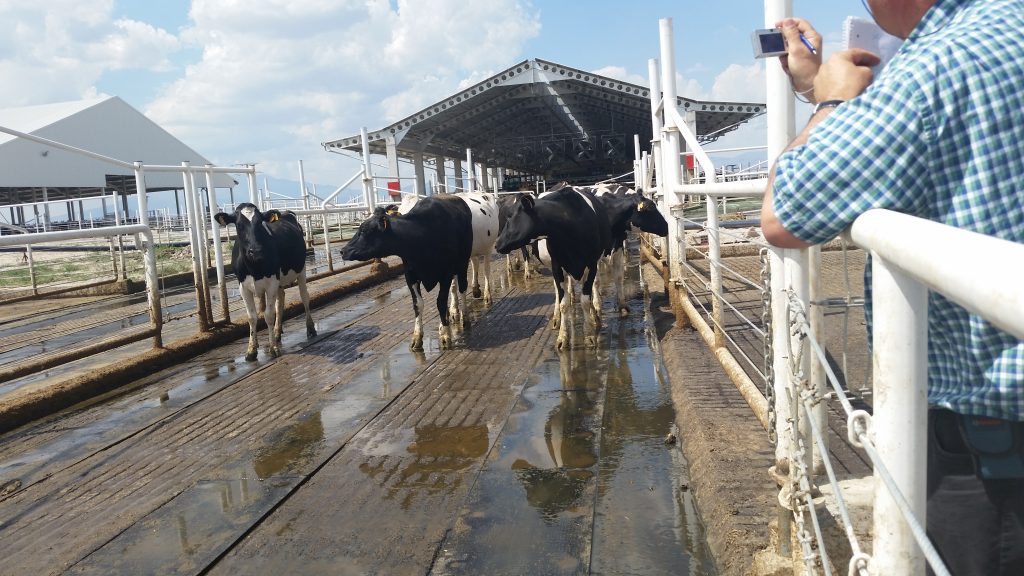
Dairy cows are on their feet for about 12 hours each day. Comfortable walking areas are essential during this time to keep the animals active. This allows optimum use of limited time available and maximizes performance potential. The cows should be able to lie comfortably for the remaining 12 hours. This gives
their claws a needed rest, thus promoting healthy horn growth. Idle standing times must be reduced, because such inactivity is bad for the animals’ claws.
Walking comfort means: More exercise – more feed intake, Sure-footedness: Sinking in gives the claw support. More frequent mounting – better heat detection
Claw health: Sub-clinical laminitis – a precursor to many complications, Soft conditions underfoot, less claw damage, The correct claw position.
Rubber can also provide abrasion: Dry walking areas – resilient skin. Metabolism. Faster return to positive energy balance, profitability and finally Walking comfort pays off.
More exercise – more feed intake
Certain behavioral parameters can provide information on whether cows can move about in the barn, fulfilling their natural needs. Poor walking comfort leads to idle standing, reducing among other things feed intake!
Cows move almost twice as much each day. It has been long shown that cows move about more on rubber flooring. Animals that are more active are also more
productive and healthier, because they do not stand idle and refrain from important natural behaviours.
Step length similar to on natural soil. Step length reveals whether the animals feel secure when walking. Comparative measurements in cubicle barns show
that cows take significantly larger steps on rubber than on concrete floors, comparable with step lengths of ca. 80 cm on natural soil.
More frequent feeding. Ruminants should consume their feed in smaller rations as often as possible in order to keep pH fluctuations in the rumen to a minimum. Cows move about more securely and pain-free on comfortable walking areas. This encourages them to feed more frequently.
Cows move more on soft walking areas. Because they feel more secure and experience no pain when they walk on the mats. Which is what we need to keep things running smoothly around barn.
Cows need a slip-resistant ground
Sinking in gives the claw support. Walking on concrete alleys, usually slip-resistant when new, gets more slippery after only a few years’ use (due to mechanical and chemical wear). Which is not fulfilling the minimum requirements regarding slip resistance any longer. According to tests carried out by the DLG, the coefficient of sliding friction must exceed 0.45. On soft rubber, the claw can sink in, which gives it the necessary support. The sensibly higher coefficient of sliding friction
confirms the better slip resistance of a rubber floor compared to a hard floor. Near-natural sinking in offers the claw sufficient slip resistance, which is the key to animal-friendly walking comfort.
KRAIBURG profiKURA with corundum – even more grip: Large walking areas in well-aerated cattle barns often happen to dry in summer, which is generally positive. Regardless of the type of floor (no matter whether concrete, rubber, tarmac or …), the dung’s drying surface can develop slippery smear layers – very much like a banana skin (dry surface, humid lower side). In this case, rubber mats with abrasive corundum incorporated in the surface promote considerably
higher grip. profiKURA rubber flooring by KRAIBURG offers this unique function and is therefore the best possible alternative for any walking area in the cattle barn.
More frequent mounting – better heat detection
Several signs shown by the animals make it possible to evaluate the slip resistance of walking areas. When the cows feel secure, they walk quickly, with big steps and with their heads raised. Frequent mounting during heat as well as licking on three legs are other important cow signals indicating a slip-resistant floor.
More frequent mounting: Clearer signs of heat through more frequent mounting with KRAIBURG KURA: even on soft floors it is normal for active animals to slip occasionally – nevertheless this does not stop natural behaviours. Soft floors also greatly reduce the risk of injury.
Improved heat detection: A hard and slippery ground may contribute to silent heat. Clear signs of heat, such as unrestricted mounting, are an important part of fertility management. Studies show that increased mounting on cow-friendly walking areas has a positive effect on heat detection.
More licking on three legs: Cows stand on three legs whilst licking only when they feel secure about the ground they are standing on. This behavior is therefore an important sign of sufficient sure-footedness. Another positive: licking of the cleft between udder and thigh helps to prevent eczema in that area.
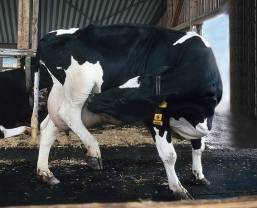
Licking of the cleft between udder and thigh helps to prevent eczema in that area.
Healthy claws are profitable
Claw health is the most important factor in the profitability of a dairy cow. Good claw health requires comfortable walking areas on top of management issues like feeding and regular claw trimming.
Sub-clinical laminitis – a precursor to many complications: Sub-clinical laminitis is quite common in dairy herds. However, affected animals are not clearly lame. What is clear is that metabolic disorders weaken the corium. Hard floors and misalignments of the claw can lead to pressure peaks. The additional mechanical load favours punctual bruising of the weakened corium. This is considered a primary cause of complications like sole ulcers, double sole or white line disease.
KRAIBURG KURA –soft flooring as the best preventive: Rubber flooring has a positive effect in cases of sub-clinical laminitis. A soft floor relieves pressure and reduces punctual bruising of the weakened corium. The affected animals can also move without pain and will walk towards feed more often – which is important for healthy metabolism and claws!
Soft conditions underfoot, less claw damage
Cows naturally are soft soil walkers. It stands to reason then that dairy cows are often afflicted with pressure-related claw diseases (e. g. sole ulcers, double soles, white line disease). Cows’ problems with hard floors are due to anatomical reasons.
Difference in length of inner and outer claw: The outer claw is naturally ca. 2 – 3 mm longer, so the cow steps on the outer claw first. On a hard floor, this outer claw must bear the pressure peak of the cow’s full weight on its own. This unnatural, strong pressure on such a small area increases the risk of mechanical traumatic claw diseases, 80 % involving the hind outer claws, indicating overloading as the main cause. On soft floor the outer claw can sink in, as the cow’s weight is distributed over the entire area including both claws. This prevents overloading and provides balance for slight misalignments. Increased activity improves blood circulation and nutrient supply. It also improves the quality of the growing horn – making it more resilient against mechanical and bacterial impacts.
KRAIBURG rubber flooring relieves pressure to claws
Incorrect load: hard floors invariably apply pressure peaks, especially to the outer claw. Natural sinking in 3 mm and even pressure distribution with KRAIBURG KURA.
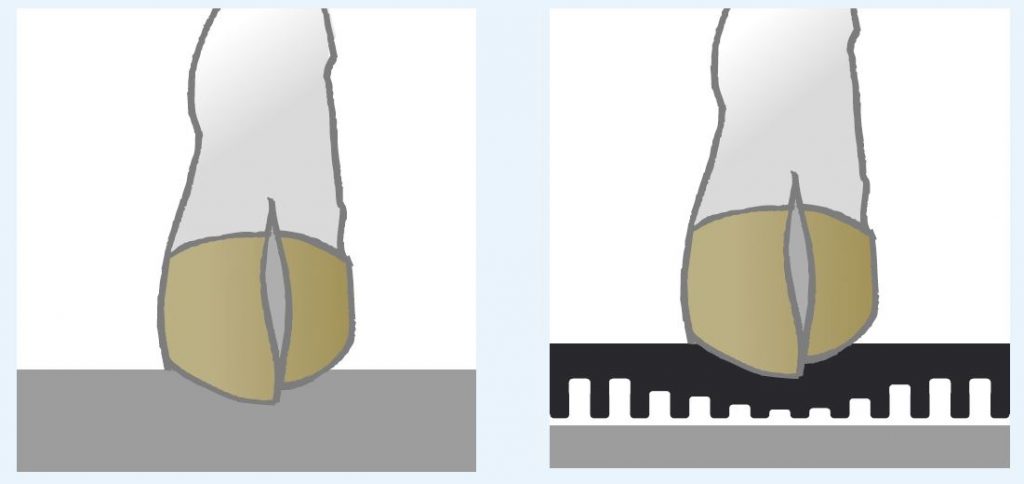
Pressure measurements carried out on bovine claws by the Leipzig University: reduced pressure peaks through use of rubber (rather than concrete), leading to better pressure distribution – more similar to pasture ground.
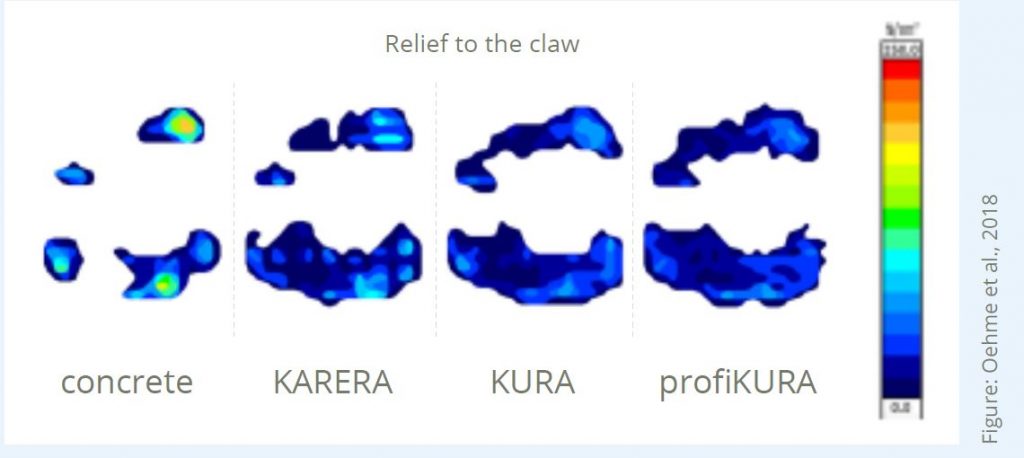
The correct claw position – as in nature
A balance between the abrasion and growth of horn is necessary to prevent claw misalignments and lameness. When observing cattle in natural environments, you can see that the animals prefer to walk on soft ground. Claw abrasion still happens: sandy constituents in the elastic soil ensure a balance between horn formation and abrasion. Hard floors also cause abrasion, but especially on the heel, because the cow steps onto the bulb first. This is the first step towards misalignment!
Causes of claw misalignment
High-performance, intensively fed dairy cows have stronger horn growth. Too much abrasion on the heel will allow the claw to “tip backwards” and the claw angle will be flatter. Abrasive hard floors also grind the claw flat, resulting in the loss of the wall edge and thus the natural slope of the sole.
too long claw = incorrect load Low heel and claw angle < 40° This leads to overloading and punctual bruising of the corium (often resulting in Rusterholz sole ulcer). A low heel increases the risk of infectious claw diseases such as heel horn erosion and digital dermatitis. Regular corrective claw trimming is therefore necessary.

Ideal claw form
Optimum load condition: High heel and claw angle 45 – 50° Uniform load conditions of the horny shoe prevent punctual bruising of the sole’s corium. A high heel lifts the bulb area away from the dirty surface and lessens the risk of infection.
Rubber can also provide abrasion
Rubber flooring is often not laid throughout the walking areas in the dairy barn in order to provide hard surfaces for claw abrasion. This kind of partial covering can trigger social stress because the animals prefer to stand on the soft ground, and lower-ranking cows get pushed off. There are abrasive soft types of rubber flooring which combine claw abrasion and natural softness.
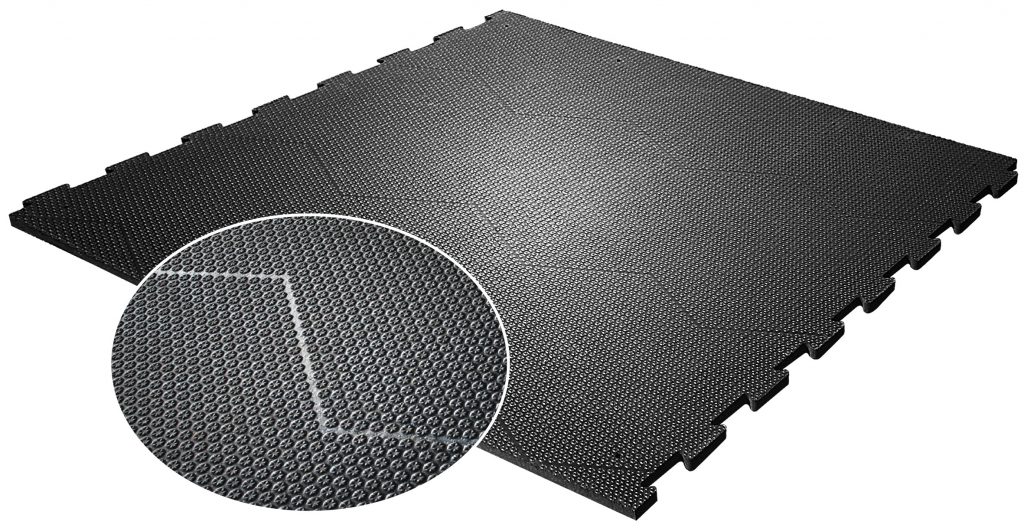
KRAIBURG profiKURA / pediKURA preserve the claw form: Soft-abrasive walking area flooring with the abrasive corundum in the surface supports
physiological claw abrasion 365 days a year. Studies indicate that the corundum mats preserve the claw angle as well as the wall edge. The soft floor keeps the outer claw from being overloaded and reduces pressure ulcers. Maintenance of the claw angle with a high heel lifts the bulb area away from the dirty surface. This helps to prevent infectious claw diseases!
Daily positional corrections as in nature:
The study shows that pediKURA helps to maintain correct claw position even between claw trimming sessions. Allowing routine claw trimming to be genuinely about care. This will take less time and involve fewer treatments of misalignments and diseases caused by incorrect load.
profiKURA and pediKURA with corundum in the surface provide a unique combination of comfortable softness and claw abrasion whilst preventing the loss of the wall edges of the claws.
Dry walking areas – resilient skin
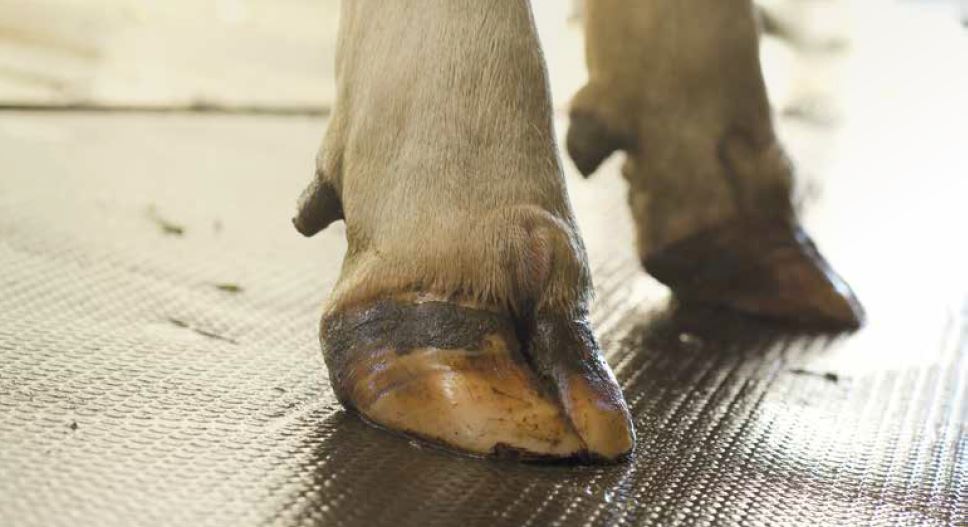
Healthy, intact skin in the claw area provides crucial protection against infectious claw diseases such as digital dermatitis and interdigital phlegmon (panaritium). It is therefore necessary to keep the walking areas – and thereby the claws – as dry and clean as possible
This can be best achieved through an integrated slope in the walking alley. Which allow liquids to run off and help keep the surfaces dry. To ensure sufficient slip resistance for the animals, rubber flooring is essential for walking comfort.
KRAIBURG rubber flooring allows for a slope in the walking alley
Proven option cross slope with urine-collecting gutter:
Urine quickly drains off by means of a concreted cross slope with a central urine. Collecting gutter and walking areas stay drier overall. Better surefootedness requires rubber flooring, ideally with corundum for additional grip. Compared to conventional concrete walking areas, 20 % emission reduction can be achieved.

All in one mat, Slope, Drainage and optiGrip-surface:
The profiKURA 3D, 3 % a slope achieved by installing the mat. Walking alleys can be concreted flat in the same way as conventional walking alleys. This solution is therefore also suitable for retrofitting in existing barns. As the flooring has no deep profiling, it is easy to clean with the scraper. The abrasive surface provides the necessary slip resistance even in very dry floor conditions.
The cross slope to the central guide is a simple and clean system! Because the flooring has no deep profile, the scraper achieves excellent cleaning results.
In addition, the profiKURA surface gives the cows “very good grip.”
Metabolism
Faster return to positive energy balance:
In the first lactation, dairy cow is subject to a negative energy balance. For subsequent lactation it is extremely important that cows can build up their mobilized body fat again before the next calving. A high intake of forage plays an important
role in this.
Regeneration of fat deposit:
Cows on rubber flooring return to a positive energy balance more quickly. This allows cows to regain their original physical condition at the end of lactation, in contrast to cows on concrete floors. These findings clearly indicate that cows on rubber flooring go to feed more frequently. Because this is the most important prerequisite for rebuilding mobilized body fat as quickly as possible.
Walking comfort pays off
Investment in rubber flooring for walking comfort: “quickly paid for itself.” by healthier claws and signs of hear show.
The average costs for a case of lameness come to about € 400*. Investment in animal-friendly walking areas for dairy cows, brings long-term improvement in claw health and walking comfort
- Higher milk yield: Studies by P.H. Robinson at the University of California Confirms that;
- Milk yield is connected directly to dry matter intake. In other words the lower a cow’s severity of lameness (locomotion score), the higher its feed intake and likewise its milk yield.
- Reduced costs of lameness:
- The severity of lameness of a herd can improve by 0.5 points with animal-friendly walking areas (= soft, slip-resistant). The higher milk yield alone will bring an increase in profit of about € 50 per cow annually. According to experience, rubber flooring in walking areas pays for itself within five years!
- Fewer days open:
- More frequent mounting and better heat detection improves fertility performance on the farm. For example with shortened calving-to-conception interval.
- Less claw damage:
- Studies show that soft rubber flooring in walking areas, reduces mechanical-traumatic claw damages. Notable findings from the field: specially active animals during heat have significantly fewer claw injuries!
Like you, we are committed to the health of your animals. We are constantly working to ensure that our products meet your cows’ natural needs, as well as requirements in terms of efficiency and environment. This ultimately pays off for you and your daily work in the barn! Please contact us if you have any questions regarding the contents of this brochure.


